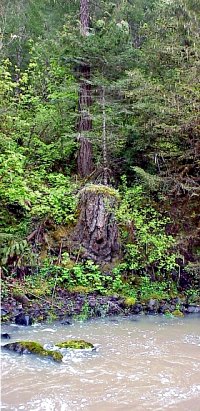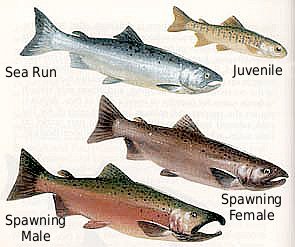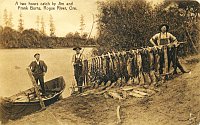~~* The Singing Falls Stream Restoration Project *~~
 ϕ
ϕ
~~*The Coho Show*~~
During the Winter of 2004-2005. In the first week of December a single Coho Salmon hen was reported in Joe Hall Creek just south of the property line. The next day I received a call from Wes Yamamoto of the Tiller District of Umpqua National Forest. He requested permission to have a fish biologist come and see the specimen. Upon his arrival here Casey Baldwin, a district USFS fish biologist, and I went to view the large female salmon. The salmon, a female, was actively building a REDD (a nesting area) in a shallow pool. While viewing her, we discussed what would be ideal conditions for salmon spawning. I told him I thought I knew of several such areas that were located along the stream within our property boundaries. Upon investigating these, we discovered a large buck and hen actively building a redd. So far, all tolled, we have counted eight fully mature Coho Salmon spawning and reproducing in the stream. There were several salmon found above our property line in Umpqua National Forest grounds also.
So begins the first steps in a journey to restore Joe hall Creek salmon habitat. The story actually begins with tales told by the old timers in this area. 89 year old Ike Wilson often remarked that upon his arrival to this area, the salmon were in such abundance that their boisterous splashing in Elk Creek would keep him awake at night. Tooter, the old Indian that grew up on this place, spoke often of snagging dog salmon as they made their way up Joe hall or Brownie Creek, both of which drain into the main watershed stem, Elk Creek. Mrs. Leona Crumpton also mentioned that it was in the mid to late 1940's that the Coho Runs disappeared. They stopped coming up Elk Creek at that time also.
So it has been better than fifty or sixty years since the Coho have been seen here at Singing Falls. Why they came that year is a question not so easily answered. Was it the particularly wet October -one of the wettest on record for here? Certainly it wasn't the logging practices, since most of the area has suffered from antiquated logging techniques for some time. You don't have to go far to see clear cuts right up to the stream edge.
Still there are some really nice stands of Old Growth timber backing the property on National Forest land. These stands are considered collateral for stream protection and on going vitality of the ecology.

riparian logging
With regard to Singing Falls itself, it was logged under more modern rigid standards that have allowed the resilient character of the forest and meadows to begin to bounce back quite nicely. When we purchased this property in 1991, it had a logging contract on it for all timber ten inches in diameter and under. To make the situation even more formidable, we were buying into a scenario where we would have responsibility for clean up and reforestation. It was a daunting prospect but really the only way we could have afforded these beautiful 77 acres. We saw it logged and have sought to nurture the land back to health with some success. The riparian zone along the stream was carefully avoided. Approximately 100 feet on each side of the entire stream was left untouched as a result of new logging practices which help keep these main arteries of new life alive and productive. This consists of several thousand feet of stream frontage.
Several truck loads of valuable large old growth trees were left behind and the falls itself left untouched to preserve its historical and natural beauty. Say it was a PR ploy by Roseburg Lumber Company if you will, but I will always be grateful to them for their generous gesture of not disturbing the sanctity of my favorite prayer spot. The area immediately adjacent to Singing Falls and behind it toward the national forest was unaffected by the logging job. I say it was nothing short of a miracle and a perfect example of how private land owners and the lumber industry can work together for the good of the environment. I am not against all logging. I have seen and participated in ecologically sensitive and sustainable logging pracitces. I am opposed to practices that destroy entire links in a large chain of natural processes that keep the land healthy. The selective cutting that was done on this property, carried by professional cutters and harvesters did a lot to alleviate the anxiety we had with regard to the impact of the harvest and the extent of the work that would need to be done to mitigate the impact. Nevertheless there is a tremendous amount of work that still needs to be done and frankly it beyond the scope of our strength and resources.
That was then (1993) and now there is new growth is sprouting everywhere. A tremendous amount of manual labor on the part of my wife and I has taken place over the years. Careful and proactive shepherding methods are important. Utilizing the land in synergy with the seasons, flora and fauna is good and sustainable husbandry. Our ultimate dream has always been to make Singing Falls a nucleus of symbiosis between our vocation and our natural surroundings to the benefit of everything concerned. It is slowly taking shape and we hope to see it well established in these our senior years.

Phases of Coho Salmon
~~*In comes the Federalies! *~~
When the federal biologist saw our excitement at the newly migrating Coho Salmon run he mentioned that there might be funds available for stream restoration and salmon habitat enhancement. Apparently there is an awakening accuring with regard to the importance of these "keystone species" to the health of the forest and the economy.
No doubt the old logging practices that were employed at Singing Falls and on the up side of Joe Hall Creek drainage had a detrimental effect on the Coho Runs. These government and industry policies involving silvaculture and efficient tree harvest have a direct bearing on Singing Falls and our vision for the future. The stream has few natural barriers to slow winter storm waters down. This has effectively wiped out natural creek bottom debris that normally provides fish, insect and animal shelter along with water temperature control. Government funded programs are in place to help reverse these problems.
Now that the Coho have been seen, our little village (Drew, Oregon) is very excited about allowing this first hatch of salmon fry to grow and make it to the Pacific Ocean some 60 -90 miles away. It will be a major task. Firstly the salmon redds themselves will have to be protected. The water levels and temperatures will have to be monitored and rescue efforts made if adverse conditions develop (which are very likely). So far, all of the Coho have been wild specimens and not hatchery fish. That is amazing in itself. These are valuable fish for that reason alone. It would be a great boon to the health of the species to keep wild genetics propagated.
top







